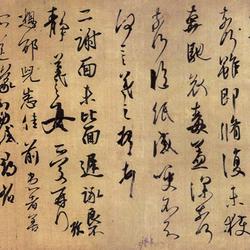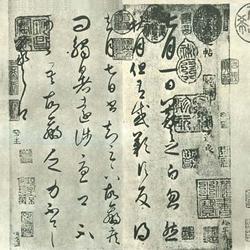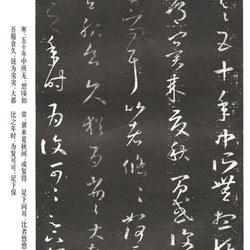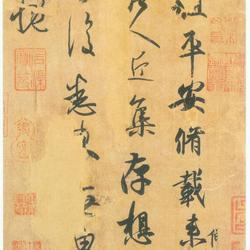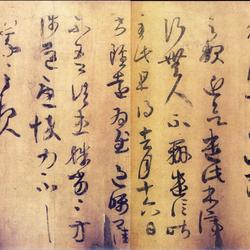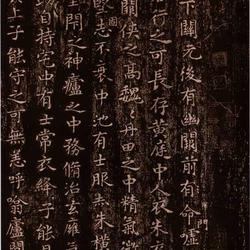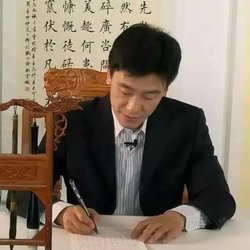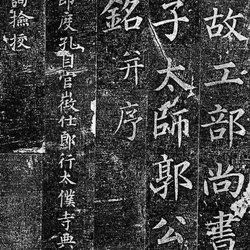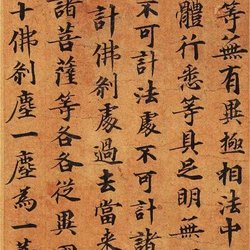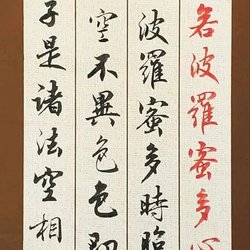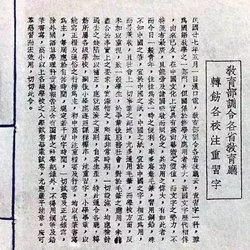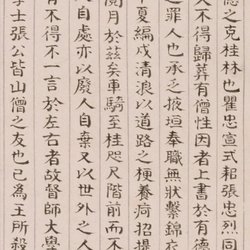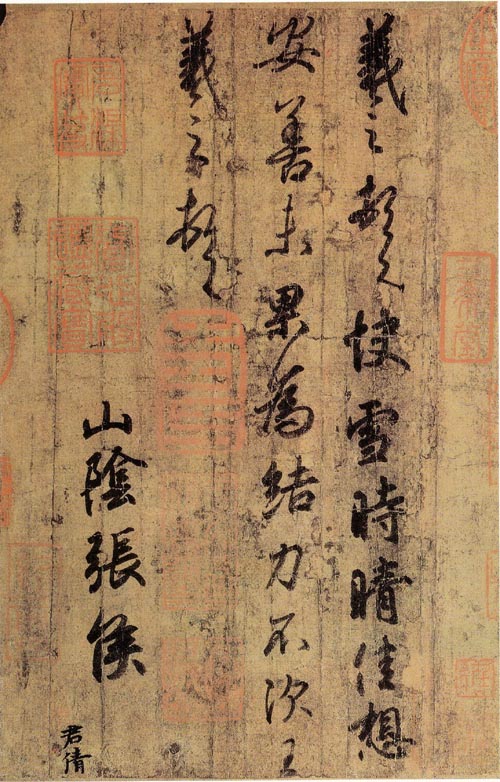
China’s top ten famous stickers:
1. Wang Xizhi's "Quick Snow and Shi Qing Tie", one of the Sanxitang Dharma Postscripts
"Quick Snow and Clear Tie" is a calligraphy work by Wang Xizhi, a calligrapher of the Jin Dynasty. It is written in running script. It is suspected that the existing calligraphy is a Tang Dynasty copy, and it has not yet been determined. The length of the sticker is 23cm; the width is 14.8cm, with four lines of running script and twenty-eight characters. "Tie to Clear Snow and Clear Snow" is a letter in which the author writes about his happy mood and greetings to his relatives when the snow clears at the beginning.
Explanation:Xi Zhi paused. Soon it will snow and then it will clear, I wish you peace and good. No result is the result. Not strong enough. Wang Xizhi paused. Shanyin Zhanghou.
Original meaning:Wang Xizhi paid his respects: It snowed for a while just now, and now it’s sunny again. I guess everything is fine there! That incident didn't help, and I still feel confused. Many things in the world are so helpless. Wang Xizhi paid homage to him, and Marquis Zhang of Shanyin consecrated him personally.
When watching the CCTV documentary "Taipei National Palace Museum", Shiqing's post explaining Kuai Xue was as follows: Hello Mr. Zhang from Shan'in, it snowed just now, and now it's sunny again. I guess everything is fine where you are! I couldn't go to the last party and I felt very depressed. The person who delivered the letter to your family said that he could not stay here longer and had to go back quickly, so I will write these first. Yours sincerely, Wang Xizhi.
Appreciation:
After the heavy snowfall, the weather turned sunny, and Wang Xizhi used this short note to express his greetings to his friends. The last line "Sanyin Zhanghou" may be the name of the recipient. It was originally written on the cover of the letter, but is copied here together with the original on the same piece of paper.
This piece of calligraphy is mainly composed of round pens that hide the edge. When starting and closing the pen, the strokes, hooks, and waves are not exposed. The brushwork is mostly circular from horizontal to vertical. The structure is even and stable, showing calmness and calmness. The Ming Dynasty connoisseur Zhan Jingfeng described its characteristics as "round, vigorous, elegant, leisurely and leisurely, and unfathomable in taste", and believed that Zhao Mengfu was influenced by this calligraphy. However, Wang Xizhi was restrained and submissive, while Zhao Mengfu showed a slight edge. Comparing the inscriptions and postscripts of Zhao Mengfu, we can get this impression.
The characteristic of Wang Xizhi's calligraphy lies in the graceful "body posture". "Ti" refers to the shape and posture of the word "knot". "Shi" refers to the rhythm produced by the strokes. Taking the word "kuai" as an example, the left and right parts are facing each other. There is an echoing relationship. The right shoulder of "夬" is slightly higher, and the last stroke is right, which harmonizes the tilted posture. The character "雪" has a similar situation. The upper part is tilted to the left, and the last horizontal stroke has a downward-rightward stroke, so the center of gravity of the entire character is also adjusted. In the first line, it feels like the “Qi” is flowing consistently up and down. Why do you feel this way? If you only look at the horizontal strokes of each character, you can find that the angle of inclination is roughly the same, and the center of gravity of the characters in the same line is also on the same center line. There are some changes in the second line. "Guo" has continuous strokes, and the spacing between other characters It is sparse and the center of gravity also changes from right to left. These changes appear natural and give these short three lines a rich sense of beauty.
Recap history:
Many people believe that "Kuai Xue Shi Qing Tie" is another masterpiece of running script second only to his "No. 1 running script in the world" "Lanting Preface". Zhao Mengfu, Liu Geng, Hudu Taer, Liu Chengxi, Wang Zhideng, Wen Zhenheng, Wu Ting, Liang Shizheng and others all expressed surprise and admiration in their postscripts. Qianlong loved calligraphy all his life. He deliberately searched for famous calligraphy works of the past dynasties, compiled them from hundreds of calligraphy masters, and pursued the essence of two kings. He cherished "Quick Snow and Clear Tie" very much. In front of the post, he wrote eight small characters "unparalleled in the world, unique in ancient and modern times" and four big characters "amazing skills". He also said: "The dragon leaps over the Tianmen, and the tiger lies in the Phoenix Pavilion." There are twenty-eight characters in the book, and each word is a pearl. It is known as the "Twenty-Eight Li Pearls". He hid this calligraphy together with the three Jin people's calligraphy of Wang Xun's "Boyuan Calligraphy" and Wang Xianzhi's "Mid-Autumn Calligraphy" in the Yangxin Hall. In the Xinuan Pavilion, there is a plaque "Sanxi Hall" written by Emperor Qianlong, which is regarded as a rare treasure. Wang Xizhi's "Quick Snow Shi Qing Tie" was regarded by Emperor Qianlong as the first of the "Three Xi". In the 12th year of Qianlong's reign, he selected 134 authentic calligraphers from the Wei, Jin, Tang, Song, Yuan and Ming Dynasties collected in the imperial palace, including San Xi, and copied them on stone. , named "Sanxitang Dharma Tie". The "Yue Gu Building" was built in Beihai in Xiyuan, and the above-mentioned carved stones were embedded in the walls of the building. The rubbings were circulated to show the model of Linchi. The original copy of Sanxi is still hidden in the Sanxi Hall of Yangxin Hall.
According to the many inscriptions, collection seals and related book records on the attached pages of this post, "Kuaixue Shiqing Tie" was once in the imperial palace of Xuanhe in the Song Dynasty, in Mifu's "Baojinzhai" in the Song Dynasty, and in the imperial palace in the Yuan Dynasty. There is an inscription and postscript by Zhao Mengfu on it. It was owned by Zhu Chengguo and Wang Zhideng in the Ming Dynasty, and by Feng Quan and Feng Yuanji in the Qing Dynasty. On August 18, the 16th year of Kangxi's reign in the Qing Dynasty (AD 1677), Feng Yuanji presented it to Emperor Kangxi and entered the inner palace. In 1949, the Kuomintang troops were defeated in the civil war. When they retreated to Taiwan, they took with them not only a large amount of gold, but also 2,972 boxes of exquisite cultural relics that had been moved south. This part is a masterpiece among the cultural relics of the Palace Museum, such as exquisite handicrafts, jade cabbage, jade incense burner, jade lotus leaf-shaped brush wash, etc., including Wang Xizhi's "Quick Snow and Clear Tie". Nowadays, "Three Hopes", "Boyuan Tie" and "Mid-Autumn Tie" are now in the National Palace Museum in Beijing. Only "One Hope", "Quick Snow and Clear Tie" is collected in the National Palace Museum in Taipei. The "Three Greeks" have not yet gathered together, which is a deep regret for the Chinese people.
"Mid-Autumn Tie" is said to be written by Wang Xianzhi, and the word "Treasure" on the post was inscribed by Emperor Qianlong himself. However, according to expert appraisal, "Mid-Autumn Tie" and "Kuaixueshiqing Tie" were copied by later generations, and only Wang Xun's "Boyuan Tie" is authentic.
Introduction to Wang Xizhi:
Wang Xizhi (303-361) was a native of Linyi, Shandong Province, and later moved to Kuaiji, Zhejiang Province. He was named Yi Shao, known as Wang Youjun in the world, and was known as the "Sage of Calligraphy". He came from a well-known official family. He traveled south with his father at the end of the Western Jin Dynasty and served as a general of the Right Army and internal history of Kuaiji. He resigned during the Yonghe period of the Eastern Jin Dynasty (345-356) and traveled extensively with famous people in the East. He is passionate about poetry, music and calligraphy. He has a good nature and once traded his writing for a goose. According to legend, an old lady in Jishan, Shaoxing sold a bamboo fan for 20 yuan. Each fan in Xi's book had five characters, and the value increased to 100 yuan. People rushed to buy it. Wang Xizhi first learned calligraphy from Mrs. Wei, but later changed his learning and learned from the strengths of others. He studied cursive calligraphy Zhang Zhi (died around 192), regular calligrapher Zhong Yao (151-230), Cai Yong (133-192), Liang Hu (active in 2 In the second half of the 20th century), Zhang Chang (died in 206) and other books, he carefully studied the style, added and detracted from the ancient methods, changed the simple calligraphy style of Han and Wei, and created a beautiful and flowing style. Therefore, people in the Tang Dynasty praised him: All dharma, prepared into one family, will be the master of all ages."

